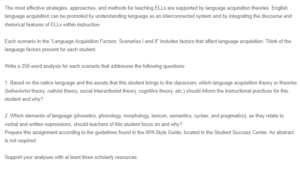Language Acquisition Factors
Nativist theory
The nativist/innatist theory by Naom Chomsky states that children have an innate ability to learn languages. Through the Language Acquisition Device (LAD), human beings can learn different languages. The presence of Universal Grammar (UG) eases the process of acquiring new languages. The process of learning languages is easiest during the critical period. The critical period is from a child’s birth to the age of nine years (Aljoundi, 2014). During this period, children such as Ahmad and Anale can easily acquire other languages. After the age of nine years, the process is more difficult. Therefore, both Anale and Ahmad can still acquire the English language more comfortably and efficiently than older learners. This theory is critical in guiding the instruction of the two learners.
Interactionist theory
Vygotsky developed the theory. The theory recognizes the role that external factors play in a child’s language development process. It highlights the importance of environmental and biological aspects in this process. Children have an ardent desire to communicate with other individuals. This desire acts as a motive to learn a language for communication. Thus, the process of learning a language could also be driven by biological and environmental factors (Rudd & Lambert, 2011). The two learners, Anale and Ahmad, may want to communicate and interact with the children in their classes without any language barriers. This element could lead them to learn words that will enable self-expression. Therefore, this theory is ideal for guiding the process of instruction.
Elements of language
The teachers should begin with speech sounds (phonemes). This is the most basic aspect of any language. The students need to understand the sounds that each word makes before they can proceed to more complicated elements of the language. Through phonology, both Ahmad and Anale will understand the rules that govern the combination of sounds. The second element that the teachers should prioritize is morphology, which teaches the formation of words. This would lead to the study of suffixes and prefixes that give varied degrees to the same word (Paris, Ricardo, & Raymond, 2021). For instance, the learners would understand the difference between ‘write’ and ‘rewrite.’ The teachers would explain to the children the technique they can use to differentiate such words. This facilitates their communication with others as well as writing.
The third aspect of prioritization is syntax. Syntax relates to sentence formation. It also highlights the rules that govern the combination of different words, phrases, and verbs to lead to a sentence. Once the children understand pronunciation and meanings, they can create sentences. These sentences will facilitate their communication with other learners. They can express themselves verbally or in writing to others, making social interactions and learning easier. This step should also increase their confidence within the social circles and in the classroom. Semantics are also important because the learners can learn more about the relation of words to others through their meanings (Paris, Ricardo, & Raymond, 2021). They can learn the meaning of words in sentence form. This eventually leads to pragmatics, which is a broader aspect of the English language. The learners, at this point, will start to understand each sentence’s contribution to the meaning in specific contexts. The consideration of these elements should be gradual, starting from the most basic.
References
Aljoundi, E. K. (2014). Language acquisition theories. https://doi.org/10.13140/RG.2.1.1381.1607
Paris, Ricardo, & Raymond. (2021). Introduction to Linguistics.
Rudd, L. C., & Lambert, M. C. (2011). Interaction Theory of Language Development. doi:https://doi.org/10.1007/978-0-387-79061-9_1522
ORDER A PLAGIARISM-FREE PAPER HERE
We’ll write everything from scratch
Question
The most effective strategies, approaches, and methods for teaching ELLs are supported by language acquisition theories. English language acquisition can be promoted by understanding language as an interconnected system and by integrating the discourse and rhetorical features of ELLs within instruction.

Language Acquisition Factors
Each scenario in the “Language Acquisition Factors: Scenarios I and II” includes factors that affect language acquisition. Think of the language factors present for each student.
Write a 250-word analysis for each scenario that addresses the following questions:
1. Based on the native language and the assets that this student brings to the classroom, which language acquisition theory or theories (behaviorist theory, nativist theory, social interactionist theory, cognitive theory, etc.) should inform the instructional practices for this student and why?
2. Which elements of language (phonetics, phonology, morphology, lexicon, semantics, syntax, and pragmatics), as they relate to verbal and written expressions, should teachers of this student focus on and why?
Prepare this assignment according to the guidelines found in the APA Style Guide, located in the Student Success Center. An abstract is not required.
Support your analyses with at least three scholarly resources.

